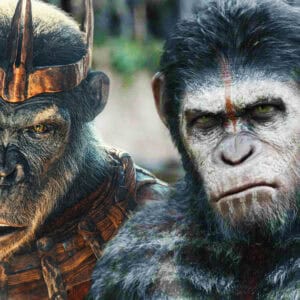
Last week FOX invited us to a kind-of-seminar deconstructing the WETA effects of RISE OF THE PLANET OF THE APES at CalTech where they screened footage, compared a few scenes to show the technological process behind the photo-real apes and hosted a panel discussion with Rupert Wyatt (Director of RISE OF THE PLANET OF THE APES), Joe Lettieri (WETA VFX Supervisor) and Andy Serkis (from London via Skype). I was lucky enough to attend and share some thoughts on what was shown.
Let’s start off with descriptions of everything that was shown, all of the footage was from the first half of the film and most have been clipped online now or described at the comic-con presentation, here are observations from other noteworthy scenes:

– While it wasn’t shown, we were told the movie opens in the jungles of the Congo, where a chimp referred to as “Bright Eyes” (that will later become the mother to the protagonist, Caesar) is plucked out by scientists and used as a guinea pig for Will’s (James Franco) cure to Alzheimer’s.
– Bright Eyes gets her name because she is the first chimp to be tested with the drug (which regenerates dead cells) so she became the first to display the drugs only noticeable side affect: the transformation of the patient’s natural iris color into a bright green.
– An early scene shows Will giving a presentation of his drug to investors; he is doing a pretty good job at winning them so far and decides to top it off by introducing them to his first successful victory, Bright Eyes. We cut back to the lab where two wrangler assistants attempt to lure Bright Eyes out of her cage with soda. The chimp won’t budge from under a makeshift fort. The assistants mention how unusual this was for their normally friendly primate. As Will grows a bit impatient the assistants use a neck brace to drag her out. She grows hysterical and runs wild. Security alarms are activated and the investors panic when Bright Eyes bursts through a glass panel and literally crashes the meeting. Needless to say, Will didn’t get any funding that night.
– Immediately after that incident and without further financing to sustain the dozen or so other chimps used for testing, Will and the board decide to terminate all of the test subjects. After euphemizing the chimps, Franklin (Tayler Labine), an assistant, realizes that Bright Eyes wasn’t reacting from the drug but was protecting her newborn, unknown to the team. He shows the baby chimp to an unsympathetic Will and professes that after all of the death he had to deal that night, he couldn’t take the life of this one. So Will takes little Caesar home…
– Years go by and Will grows to love Caesar, who is now confined at his home with his ailing father (Lithgow). We learn that the drug is genetic, as Caesar developes to be an incredibly gifted chimp with unusual green eyes. After the dangerous incident between Will’s father (Lithgow) and his neighbor, Caesar is forced to go to a facility run by Brian Cox where he will be isolated from humans but cared for amongst other primates.

There is a scene where Will drops Caesar off at this facility that pretty effortlessly tugs at the heartstrings, Rupert mentioned how chimps have the intellectual and emotional capabilities of a four year old human and the scene plays like you’d imagine- tuff. Caesar acts like a child pulled apart from his parents. Rupert further described how they approached Caesar’s time at the facility, which by all accounts looks like a large interior jungle gym you’d see at a zoo. “Caesar wants to shake their hands but of course they don’t understand him. He is a freak in both worlds.” Interestingly, there is an Alpha primate at this new “prison” and Rupert compared Caesar’s next move to that of someone entering jail- take out the alpha before they make you their bitch. Using his wits, Caesar quickly rises in the ranks. We were then shown a scene where Brian Cox hears a kind of gravely chant in the jungle gym, he looks on to see Caesar teaching the other primates how to chant using their voice and their hands… it was a quiet scene and genuinely pretty eerie stuff.
I’m curious about this movie and honestly the footage looked solid. More importantly, even in the few moments I had watching Caesar it is obvious that Serkis and the animators get us to genuinely care about the poor chimp. Something I found interesting with the primate effects (especially concerning Caesar) is how they’ve basically worked in a plot point ridding them of any potential “uncanny valley” criticism usually attributed in the characters eyes. Because these aren’t Navi but animals we’ve all seen, the audience has a picture perfect idea of what they should look like. Not getting it 100%, like not getting CGI humans 100%, can lead to a detachment between the characters and the audience. That won’t be the case with RISE OF THE PLANET OF THE APES because the apes are supposed to offer an unusually eerie quality in their green eyes due to the “cure”, which is kind of a neat way of getting around a potentially dangerous narrative roadblock.

In a very cool move, we saw most of these clips alternating between the final product and the footage shot on set with Andy in his performance capture outfit. Andy explained that this was the first ever mo-cap work to be done on set with non-mo-cap actors. The LOTR trilogy used Andy on set but only to react for the other performers, the actual motion capture was done back at the sound stage. These comparison clips were without a doubt the most fascinating part of the entire panel for two reasons; one, you could easily see that EVERY subtle characterization was one-to-one already done on set by Andy and two; the man is just a damn good actor. You could play these scenes with just Andy in a black suit and it wouldn’t take a lot of imagination to let the story take over.
Speaking of the story, the director compared the movie to two other movie archetypes that kind of confused me. First, he said “this is a classic tale in the vein of FRANKENSTEIN” which is an understandable comparison, but understandable for the first half of the movie. He compared the second half to a revolutionary story like SPARTACUS. This is where I started to worry. The archetypal KING KONG/FRANKENSTEIN tragic monster very much came across in the footage I saw. The problem is that we know going in that this story is ending with apes taking over the entire planet. Those tragic monsters like Kong and Frankenstein are sympathetic but we know they have to be put down. Where they are taking the story will be the complete opposite.

One of the things I didn’t think worked for this summer’s SUPER 8 was how it started off being that tragic monster movie but took an awkward turn toward the end that seemed to belong to an entirely different kind of story. What happens when the tragic monster turns into Spartacus and leads a revolution not only against his creator but the world? When asked if this is a reboot or a remake, Rupartt sort of put off directly answering the question by saying it is “a reboot, I guess you can call it but we are working our way back toward the original with future films”. I can’t help but get the feeling that the Caesar story they want to tell might not mesh with the apocalyptic inevitable turn of events we know will happen. Maybe I just feel this way because they were focused on discussing motion capture more than the mob of CGI primates that happens in the third act. Either way it’s a delicate knot I hope they’ll untangle in a unique way with the final product.
All in all the WETA performance capture technology has gone a hell of a long way since it premiered in Middle Earth ten years ago. I really appreciate how WETA describes it as the next step in make-up effects. Andy Serkis put it well when asked what he wished for in the future with performance capture, “Obviously for actors to not wear the head cameras and for them to wear costumes but more importantly, everyone is sidelined by the technology. My wish is to embrace it and remove those hesitant layers.” Joe Lettieri emphasized this point and spoke specifically of the actor’s authorship behind it, “There is a bit of a cognitive gap people have to get over. For the last hundred years the idea of performance and the recorded image of that performance are one in the same, and now we’ve separated that. It’s something that many are still wrapping their heads around.”



















Follow the JOBLO MOVIE NETWORK
Follow us on YOUTUBE
Follow ARROW IN THE HEAD
Follow AITH on YOUTUBE